Soviet main wheeled APC
With the BTR-152 and BTR-40, the Soviet army had the experience with APCs needed to make evolve the type. The two model greatest issue (to be open-top) was corrected in mid- or late-production, but their real limitations were fully exposed in combat during the Suez crisis. The reports published after the actions had the seeds of a new design, which was eventually led to the first all-enclosed, NBC, amphibious, six or eight-wheeled BPC in the formula familiar to us now. In 1956-57 a decision was made to built two kinds of APCs to serve different units. The tanks divisions would have the tracked BMP-1, while the rifle (infantry) divisions would be equipped with a cheaper wheeled APC or "armored car" (Bronetransporter). Two design bureaus were contacted, GAZ V. A. Dedkov) and ZiL (Rodionov and Orlov).1957-59 prototypes
The original specification did not mention a 6 or 8-wheeled formula but an all-wheeled drive with independent, at least two turntable axles and with extensive fording capabilities to operate with tanks. GAZ model was fully enclosed, angular, with 8 heavenly spaced tires, but not treated NBC. It was released in 1958. ZiL studied the ZiL-153, a six-wheeled vehicle which was similar in hull shape. Alongside these three, 8x8 prototypes built by KAZ were also tried. The third, Ob'yekt 1015B, had a turret armament and stream propellers. All these prototypes were confronted in extensive trials in 1959. Although Ob'yekt 1015B had the best results, GAZ was chosen because of their experience in this matter and industrial capabilities, to produce the BTR-60P, which was also simpler and low-tech, better suited for mass-production. The BTR-60P had a capacity for 16 soldiers but was open-top, unarmed and lightly armored. These tradeoffs were later corrected on the BTR-60PA in 1963. The "P" stands for plavajushhijj – "swimming".
Design
The BTR-60 looked like an MPV sloped hull with reservations for the massive wheels, and compartmentation between the crew (front), troops (center) and engine (rear). It was revolutionary for the time. The crew compartment originally comprised a driver (left) and commander (right), but with the appearance of the armed version (PAI-PB-PZ), a third member, the gunner, was located behind them, center, on an elevated seat. He manned the turret by a hand crank and used a PP-61A optical sight. Access was initially by the sides, but during production to improve amphibious capabilities, these were shifted to the top ( BTR-60PA). The hull was seaworthy due to the boat-shaped nose, and by rough seas, improved by the extended trim vane.On the BTR-60B, the gunner had its own right-hand side door, while the commander and driver were given pistol ports. On early models, only the driver had the periscope (the commander had a removable OU-3 infrared searchlight.), but later each had three periscopes. R-113 and more rarely R-123 radio kits were carried. Night vision was gradually improved by the adoption of the TKN-1 connected with the OU-3 illuminator for the driver and TWN-2 sight for the driver. In addition, there were the four headlights, including two infrared and two white.
The troop compartment could accommodate 16 fully-equipped soldiers on the first version (covered by a tarpaulin), replaced later by a fully enclosed one, but reduced in capacity. There were six pistol ports, large enough to fire the standard Kalashnikov, three per side, on the upper slope. Their positions were shifted on the BTR-60PB. Due to the engine location, the crew had to disembark and climb into the vehicle through roof hatches. However, the BTR-60P had side doors, later eliminated (used as emergency exits). A single one, the left-hand side, was reintroduced on the PB. Steps and vertical handrails were also provided. With the PA, extra ones were added between the wheels.
The BTR-60 was amphibious, propelled by a water jet protected on land by opening lids. A trim vane was erected at the front when fording. Alongside the troop compartment, there were two pintle mounts to accommodate extra 7.62 mm PKT/SGMB/PKB machine guns with 3,000 rounds in store. This option was common to the P/PA/PA-1 and later eliminated on the PAI/PB when replaced by the conical turret. In alternative, to the central front light MG, a 12.7 mm DShK 1938/46 heavy machine gun (500 rounds) was installed on the PA/PA-1.
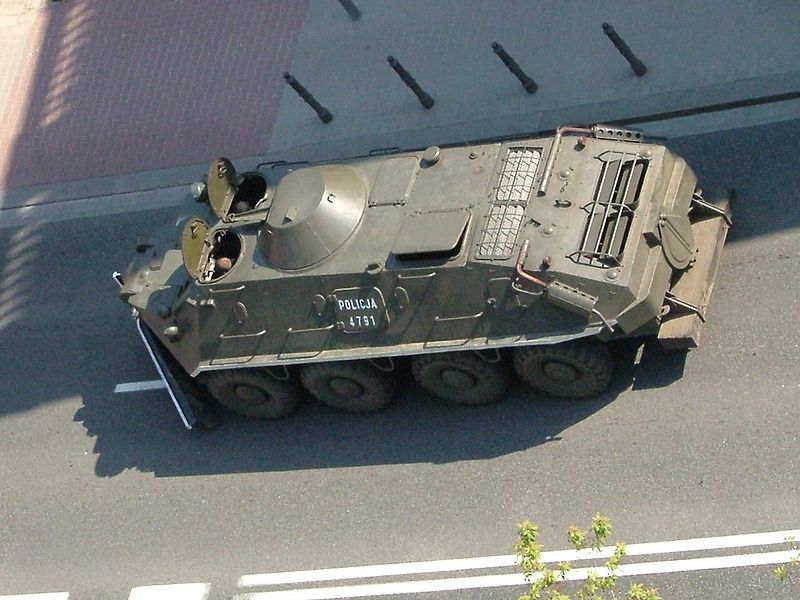
The protection was not better than on previous APCs, with a maximum of 7-9 mm on the front beak, 5-7 mm rear, 7 mm on the top, and sides. Later it was raised to 10 mm to the front and homogeneous 7 mm anywhere else, starting with the BTR-60PAI. Finding the appropriate engine was found difficult, but ultimately GAZ provided a combination of two six-cylinder gasoline GAZ-40P engines (67 kW), side by side, giving a combined power of 180 hp (134 kW). Each was related to two directional axles (right =second+fourth, left=first+third). Each axle had its own differential and hung to its own transversal torsion bar, while each engine had its own gearbox with a single-shielded hydraulically controlled clutch. There was a significant gap between the first two and last two axles. Due to the adoption of truck engines, not tested and conceived for extreme military use, breakdowns and reliability issues plagued the early life these BTRs and led to devise driver careful management instructions. In addition, the same engines had a low-ignition point and high consumption. These issues were not corrected before the BTR-80. Due to the additional weight, the power-to-weight ratio was diminished significantly from 18.4 to 17.5 hp/ton.
Production
The BTR-60P was the initial production model, accepted in service in December 1959. Production started at the Gorkovsky Avtomobilny Zavod and spanned from 1960 to 1963. In the meantime, the open roof was fully enclosed. This led to the BTR-60AP which had a reduction in transport capacity from 16 to 14 soldiers but granted a collective NBC protection. There were also modifications in the hatches and handrails disposition. The PA-1 from 1965 was upgraded with better engines, transmission and the R-123 radio set. Few were built as the production was shifted to the PAI. The appearance in West Germany of the HS.30 APC (one of the earliest IFVs) led to the adoption of a small turret BPU-1 (developed for the BRDM series), armed with a KPVT 14.5 mm HMG with a coaxial PKT 7.62 MG. The BTR-60PAI appeared in 1965, and in 1966 the BTR-60PB fitted with better sighting systems: The turret was shifted to the right while the telescopic sight was mounted coaxially to the left. Added to this it had NBC filtration and overpressurization system, better protection, self-sealing tires and inflation control, antennae mount on the rear right-hand side and side door. The production run of this model lasted until 1976 when replaced by the BTR-70. The late PBs were upgraded to the same sights than the BTR-70. Ultimately, the BTR-60 was gradually replaced in the 1980-90s by the BTR-80. However, GAZ performed a single production run of 100 PBs for Iraq in the late 1980s. Outside USSR, Romania was the only country producing the BTR-60 under license as the TAB-71.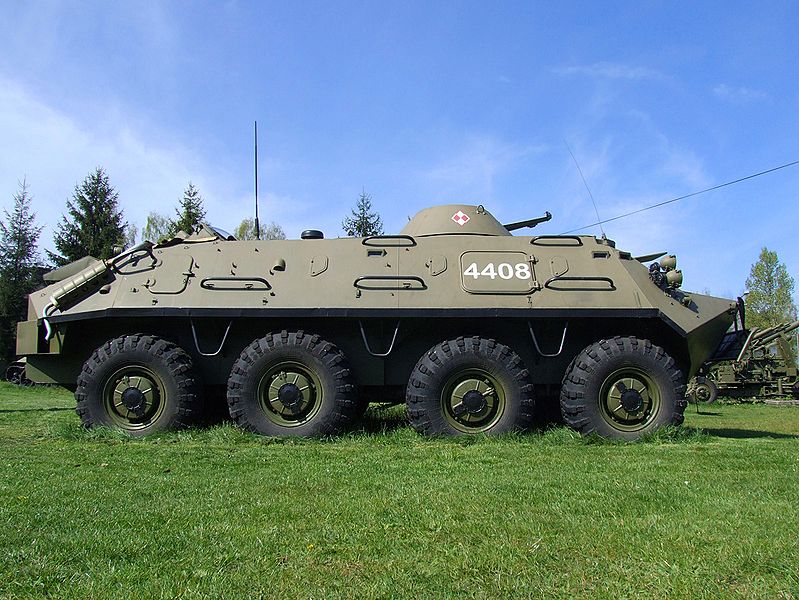
Soviet & Russian Variants
As of 1990, around 4191 of these vehicles were in service, but much less in 2002-2003, most used by the infantry (rifle battalions), 750 by the naval infantry, 280 by the coastal infantry units, but today only 17 seems to be in active reserve only.*note: the denominations between brackets are unofficial.
- BTR-60P(K)* Command vehicle with a rail antenna running all along the hull.
- BTR-60P(M)* Mortar carrier vehicle
- MTR-2 Repair vehicle with an extended open-top to the rear
- BTR-60PA(K)* Command vehicle with two side-mounted angled telescopic masts
- MTP-2 Technical support vehicle based on the PA, with a front crane, and several external stowage boxes
- BTR-60PB(C)* Equipped with a BTR-70ZS for civil agitation control and propaganda
- BTR-60PB(K)* Command version with two side-mounted angled telescopic masts
- BTR-60PBK True specialized command version with a new GAZ-4907 chassis, three radio sets, whip antennae and a massive antenna mast on the left upper hull.
- BTR-60R-145BM "Chaika" Or BTR-60U, specialized turretless command vehicle with collapsible AZI frame antenna, 10 m mast antenna, five radio sets and generator
- BTR-60PZ Late version fitted with the BTR-70 AA capable turret and 1PZ-2 periscope.
- BTR-60 1V18 "Klyon-1" Artillery command & observation vehicle, with an unarmed turret fitted with NNP-21, DV sights and rangefinder. The BTR-60 1V18-1 was the modernized version
- BTR-60 1V19 "Klyon-2" artillery fire direction center, battalion commander vehicle with R-130M radio set and extra stowage box
- BTR-60 R-145BM turretless communication vehicle with five radio sets
- BTR-60PU-12 (9S482) air defense HQ vehicle (1972) fitted with an AMU telescope mast and generator, to guide SPAAG and SA-9 or SA-13 launch vehicles. The BTR-60PU-12M (9S482M) was the modernized version which can process 99 targets instead of 12.
- BTR-60R-975 Tactical Air Control vehicle with four radio sets, SMI-2KM beacon system and generator, the M1 was the modernized version
- BTR-60R-137B USW signals vehicle
- BTR-60R-140BM SW signals vehicle
- BTR-60R-156BTR HF signals vehicle
- BTR-60R-409BM Radio relay vehicle
- BTR-60R-419BR low-frequency radio relay vehicle
- BTR-60E-351BR battery charger for signals vehicles
- BTR-60P-238/239/240/241BT PB converted as switchboard vehicles
- BTR-60MS communication vehicle with "High Ball" antennae
- BTR-60MBP Base security vehicle for Strategic Rocket units with new turret, 1PN22M1 sight, loudspeakers, OU-3GA-2 IR searchlights and extra periscope
- BTR-60PBM Russian 1st modernization phase with the BTR-80 engine (fall 1990s), modified hull sides, and fewer pistol ports (Arzamas Engineering Plant)
- BTR-60MWS 2nd mod phase at Muromteplovoz JSC (2006) with a new YaMZ-236A 195 hp diesel and MB2 modular turret with a 2A42 30mm gun
- BTR-60MWS-M 3rd mod phase (2010-2011) with modified handrails, fewer pistol ports, YaMZ-236D diesel, raised roofline, two exit doors, and MA7-02 turret with the 12.7 mm "Kord", coaxial MG and smoke grenade launchers 902V.
- 9K35M3-K "Kolchan" SAM launcher conversion (2007) by Muromteplovoz, equipped with a STRELA-10 launcher
- Irtish civilian repair vehicle with a front crane, top crate, and modified hull (missing handrails, ports, periscopes, turret)
- BTR-60PB civilian armored firefighting vehicle, with a modified hull and crate
- BTR-60PPM civilian armored firefighting vehicle, with the same modifications and extra windows plus side A-crane
Local variants
Bulgaria
BTR-60PAU (Artillery command vehicle), BTR-60PB-MD (mod-1 with VAMO DT3900/Rover TD-200 diesel, smoke grenade launchers, "Melopa" night sight, new NC lining and radio sets). The MD1 had a Cummins ISB 25.30 turbocharged diesel and other modifications and the MD3 is the export variant with KamAZ diesel engine and other modifications. Bulgaria still had some 781 of these in service.Cuba
The country was given BTR-60s and PBs, locally upgraded with the BMP-1 turret (PB), or converted as a wheeled tank with a 100 mm gun in a heavily modified turret from the T-54A. There were also two SPAAG versions with twin 23/37 mm anti-aircraft guns which took the entire crew compartment space and the hull was largely opened.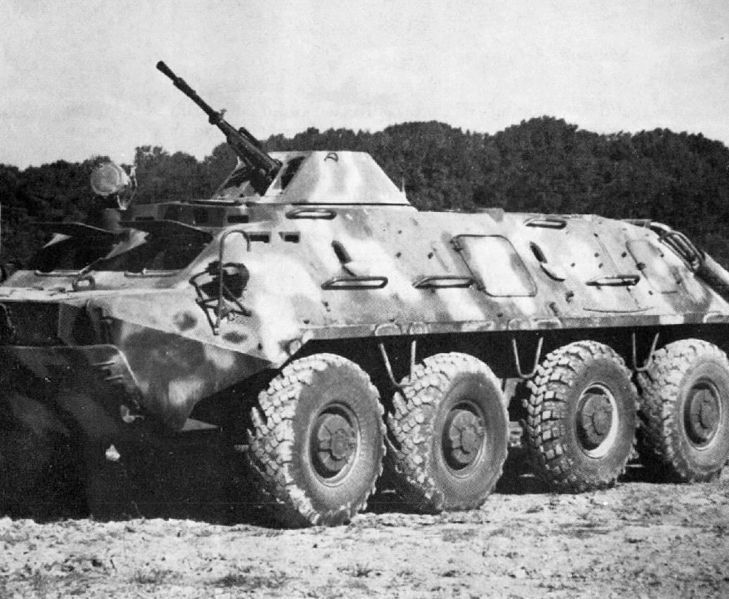
Finland
PB, PBK (second radio transceiver telescope radio antenna) and PBUM (BTR-60R-145BM "Chaika" upgrade and NSV 12.7 mm HMG).East Germany
Local denominations SPW-60P/PA/PA-S/PB. Local variants ABS artillery forward observer vehicle, BBS command vehicle for air-defense artillery batteries, PB(S) command vehicle, NZ(B) MSR/PR, R-137B, R-140BM, R-409BM, R-145BM/AKL1, R-145BM/AKL2, R-145BM/L1 and R-145BM/L2I signals vehicle, LBGS(B) telephone cable layer, and P-238/39/40/41BT switchboard vehicles.Israel
IDF captured enough of PBs to modernize and use them as the CARDOM 120/81 mm mortar system, Nimda upgrade, and the extensive Saymar upgrade, which is intended as an export package.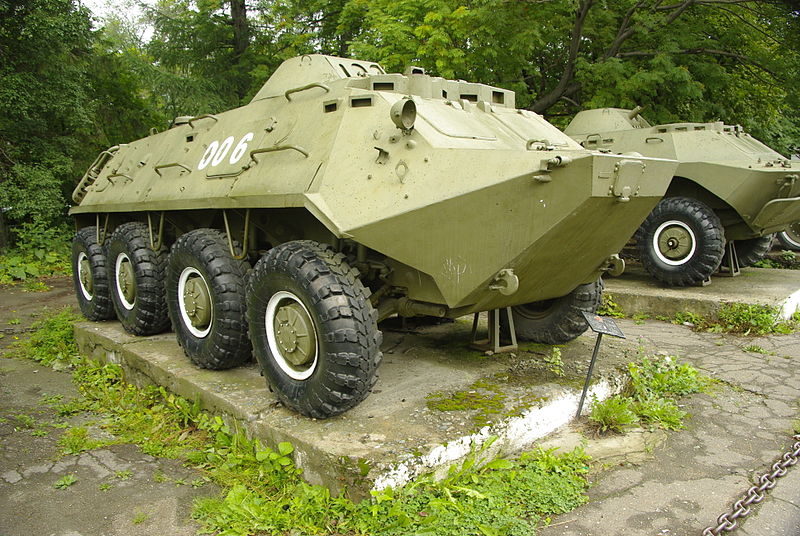
Mexico
Mexican Marines use the APC-70 PB-MX Turret-less version derived from civilian vehicles, armed with a single LMG, and Mk 19 grenade launchers.China (People's Republic of)
Four BTR-60s were captured on the occasion of the Sino-Soviet border conflict on Zhenbao Island in March 1969. They were locally dismantled and studied, then copied through reverse engineering. Details of local modifications of production are unknown but the production did not start until the mid-1970s, and it was short. Due to the bad road network of China then, tracked vehicles were preferred.Poland
The local BTR-60PB have an additional radio set, and during the martial law application, MSW automobile performed a modification on several vehicles for population control, with a two-sided breaker, additional protection and OU-3 infrared searchlight. The Milicja Obywatelska and ZOMO units operated these PAs. The Polish Ministry of Internal Affairs operated 25 vehicles, transferred to the ZOMOs, and later the Police. Only a few are kept in service, equipped for breaking barricades. When Poland was given 9K33 Osa SAMs, several PU-12 vehicles were also transferred. Poland built also thousands of the local OT-64 SKOT.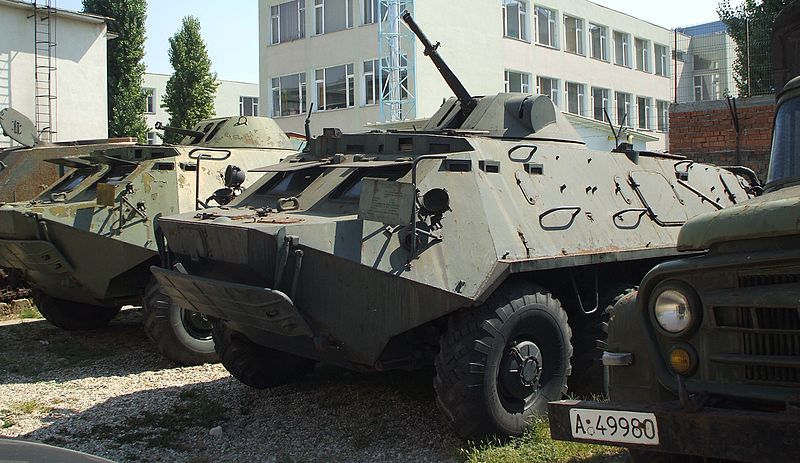
Romanian TAB-71
Built locally under license the TAM-71 upgraded with two SR-225 gasoline engines developing 140 hp (104 kW), additional periscopes, turret's left side protected sight, and 5.5 ton front-mounted winch. The TAB-71M/72 received Saviem 797-05 diesels and extra escape hatches between the wheels. The R-1450/51/52 are signals vehicles, the TAB-71 AR is a self-propelled mortar platform with M-37M 82 mm mortar (100 rounds) and the TERA-71L is an ARV version with dozer blade and crane. From 1970 to 1990, Romanian produced 1,872 TAB-71s/Ms, TERA-71s/Ls, TAB-71A R-1450s/R-1451s/R-1452s and 491 ARs, most exported. As of today, around 1300 are in service.Operators
The commercial success of the BTR-60, cheaper than the BTR-50, is impressive and resemble the T-54/55 owner's list. No less than 77 countries used (or still uses) this model and its variants. Outside of the aforementioned countries, in Europe, the BTR-60 was also used by Czechoslovakia (28 (1979), 5 (1982) and 25 (1984) PU-12s for SAM batteries) But Czechoslovakia also produced the local version of this vehicle for its own use and export as the OT-64 SKOT. Yugoslavia (operated 60 PB and 40 TAB-71), Hungary (150Ps, and 7 BPU-12s), Finland (120, withdrawn in 2006), and Lithuania (120 in 1976, withdrawn 2006).After the collapse of Yugoslavia, the Serbs and Bosnian Serbs, the Croats (16 TAB-71 captured ex. JNA) or the Macedonians (35) used it in operations. Moldova operates a mix of BTR-60 (12) and TAB-71 (121). Turkey purchased 300 vehicles from Ex-East Germany in 1990 and 23 more from Russia in 1993. Ukraine had 500 of these vehicles in service as of 1990, but this number dwindled to 176 in 2005 all probably in reserve today for scrapping. The BTR-60 is also still now in use by the republics born from the collapse of USSR, namely Abkhazia (5), Azerbaijan (around 150), Belarus (around 120), Kazakhstan (around 300 of this and BTR-50 type), Kyrgyzstan (less then 50), Turkmenistan (about 800) and Uzbekistan (around 20).
In the middle east, this model was equally attractive for many customers, as Afghanistan (600 delivered 1979-86), plus another batch in 2002. Most are still in operation today. Iran (300 in 1966 + 200 in 1986, less than 150 as of today, some converted as SPAAGS); Israel (used many recaptured vehicles, ex-Syrian and Egyptians, some reconverted as mortar carriers). Iraq ordered 250 PBs in 1970, 3500 at peak prior to the Iran-Iraq war. In 1990, still around 1500 but less -unknown numbers- in 2002. Lebanon operated some 18 vehicles, ex-Iraqi in 1988, while the Syrian provided the Druze Progressive Socialist Party militia several vehicles in 1983.
On the African continent, these were Algeria (400 still in service), Angola (three batches 74+175+250+60 between 1975 and 1988, currently 100 in service), Botswana (30), Dem. Rep. of Congo (30), Rep. of Congo (30), Djibouti (12 ex-Iraqi, one rearmed with a AML-90 light armoured car turret.), Egypt (perhaps 200 prior to 1967, 650 after, circa 300 today), Eritrea (65), Ghana (6), Guinea (20), Guinea-Bissau (35), Liberia (8 TAB-71), Libya (750 in the 1980s, 540 nowadays), Mali (10), Morocco (45), Mozambique (150), Namibia (10), Nigeria (6), Rwanda (?), Sahrawi Republic (?), Somalia (5), Sudan (?), Syria (600), Uganda (20), Yemen (500), and Zambia (13). In Asia, customers were Bhutan (?); Cambodia (200 as of today), India (deliveries starting in 1976, 812 at peak with many variants, only the BPU-16 are in service today), North Korea (1000), Laos (70), and Vietnam (350). In the Americas, users were (and are) Cuba (400), Mexico (30 converted to semi-civil standard for the Marines), Nicaragua (64) and Peru (12). The small island of Grenada operated 6 vehicles, given in 1982.
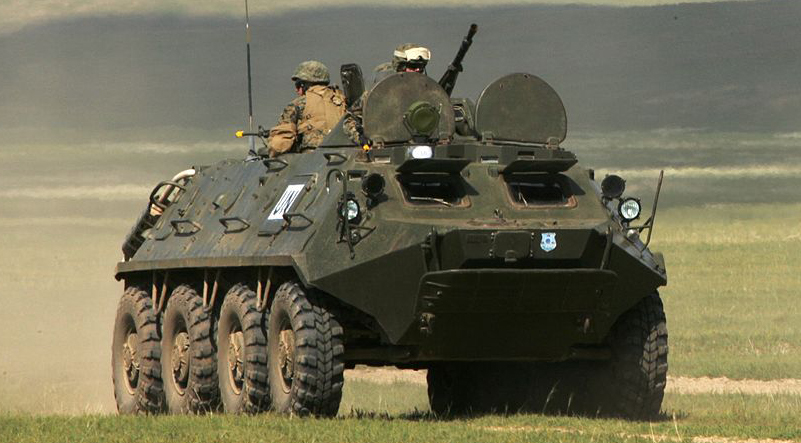
The BTR-60 in action
Due to its widespread use, the BTR-60 saw heavy action throughout the world. These conflicts includes :- The South African Border War, (1966-1991)
- The 1967 Six Day War
- The Soviet invasion of Czechoslovakia in 1968
- The Sino-Soviet border conflict in 1969
- The Indo-Pakistani War of 1971
- The Yom Kippur War in 1973
- The Lebanese Civil War in 1975-1990
- The Western Sahara War (1975-1991)
- The Angolan Civil War (1975–2002)
- The Chadian-Libyan Conflict (1978–1987)
- The Soviet War in Afghanistan (1979–1988)
- The Iran–Iraq War (1980–1988)
- The Invasion of Grenada (1983)
- The Georgian Civil War (1988–1993)
- The War in Abkhazia (1992–1993)
- The Nagorno-Karabakh War (1988–1994)
- The Romanian Revolution (1989)
- The First Persian Gulf War (1990–1991)
- The Civil War in Tajikistan (1992–1997)
- The First and second Chechen War (1995–2009)
- The operations in Afghanistan (2001), second Persian Gulf war (2003) and 2003 Invasion of Iraq.
- And contemporary conflicts like the Kurdish–Turkish war, the Civil War in Yemen, the Libyan and Syrian civil wars.
BTR-152 related links
The BTR-60 on Wikipedia
BTR-60 specifications |
|
| Dimensions (L-w-h) | 7.56 x 2.83 x 2.31 m (? x 9.28 x 7.58 in) |
| Total weight, battle ready | 10.3 Tonnes (11.4 tons) |
| Crew | 2+16 (later 3+14) |
| Propulsion | 2× GAZ-40P 6-cyl. gas. 180 hp (134 kW) combined P/w ratio 18.4 hp/tonne (13.7 kW/tonne) |
| Top Speed (land/water) | 80 kph(26 mph)/ 10 kph(6.2 mph) |
| Range (road/off road) | 500 km (370 mi) on 290L fuel |
| Armament - see notes | PA: 1x 14.5 mm KPVT HMG, 1x 7.62 mm KPT MG. |
| Armor | 5 to 10 mm (0.2-0.2 in) |
| Total production | Approx. 25 000 |
Gallery
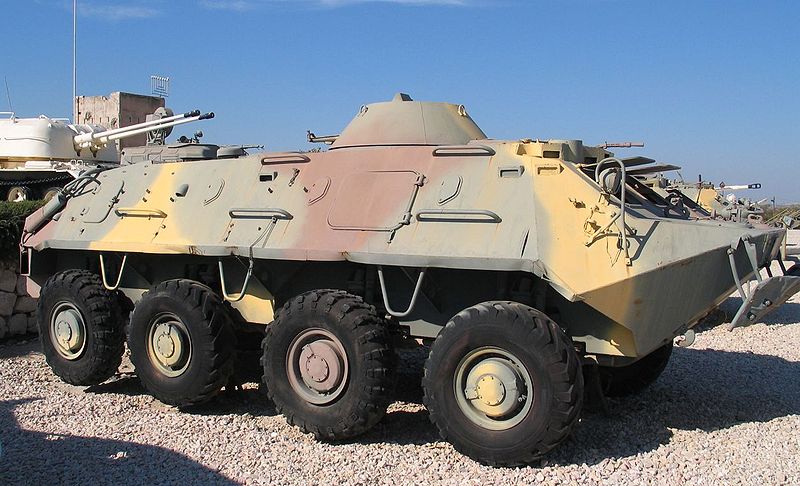
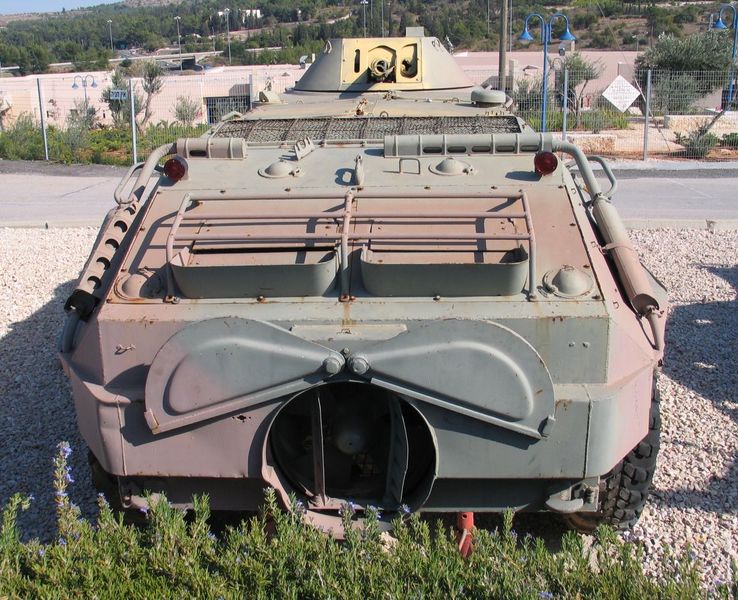
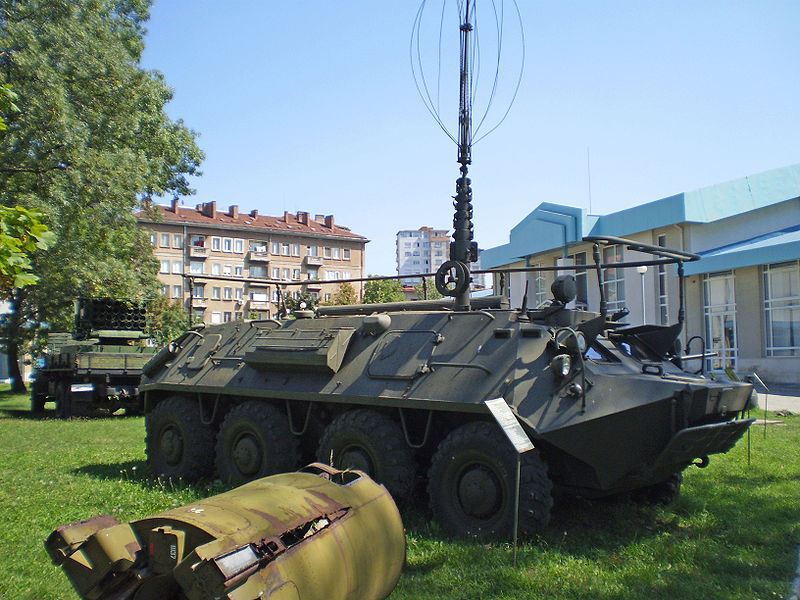
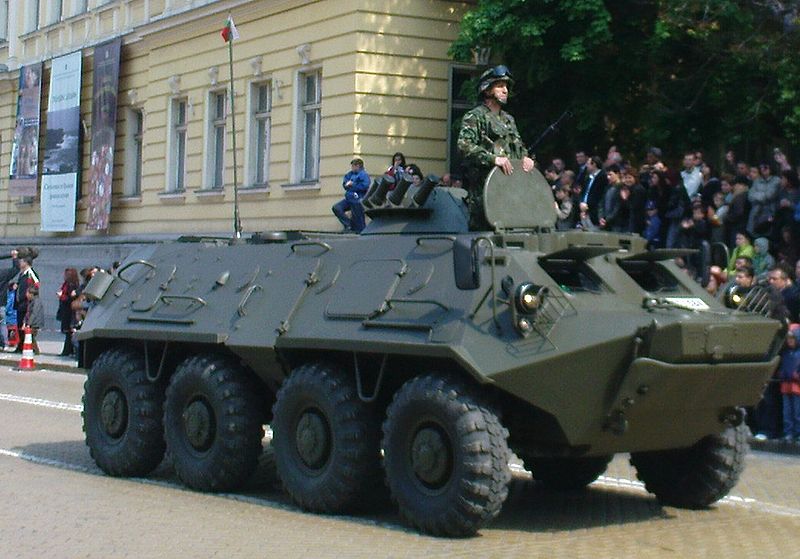
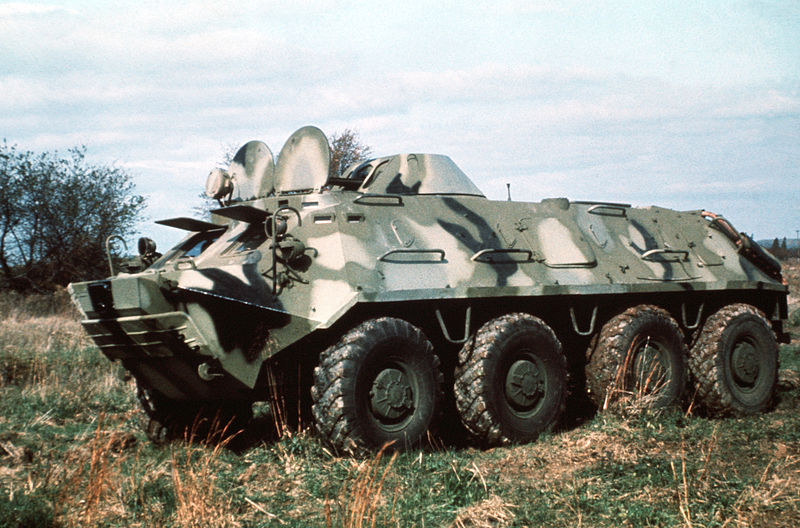
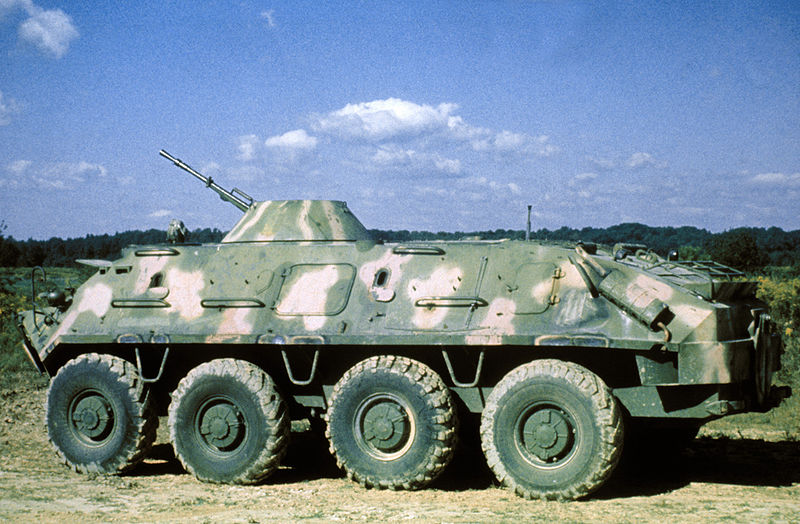
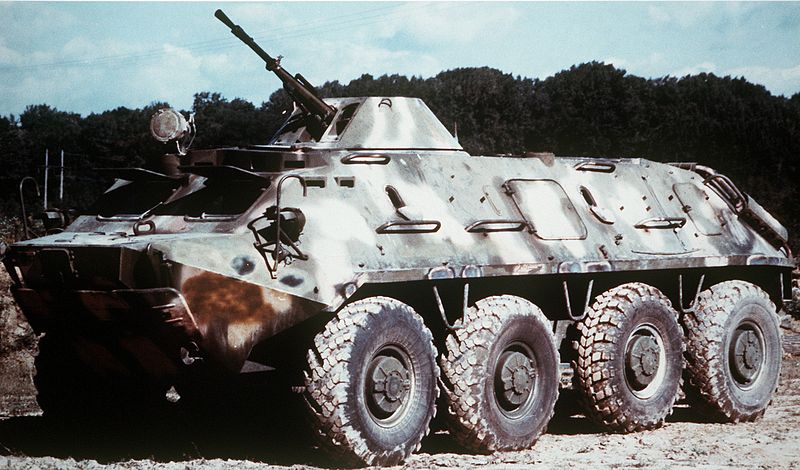
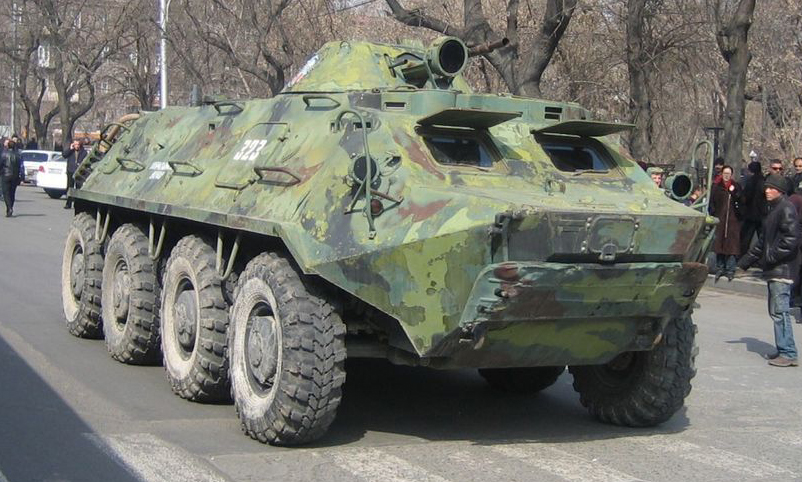
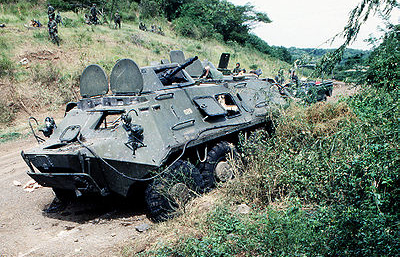
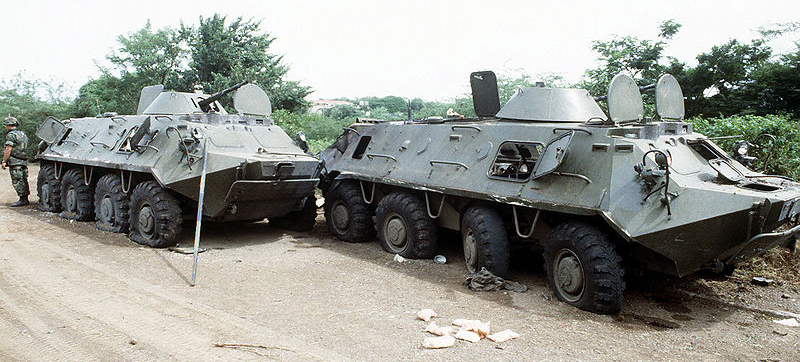
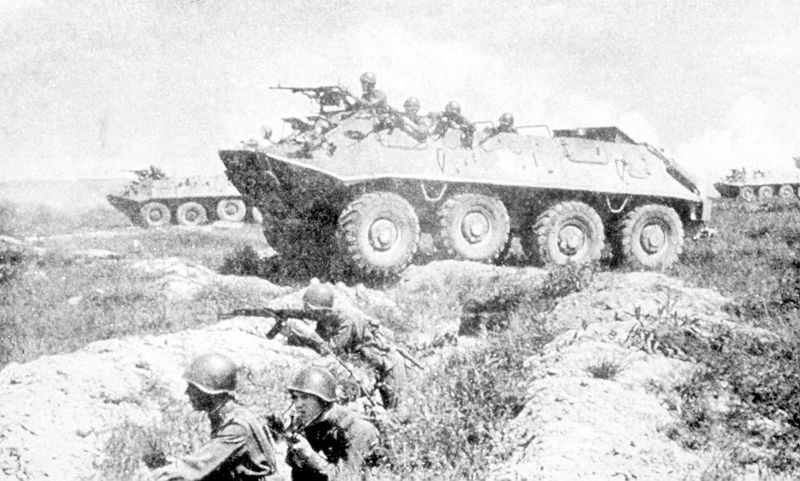
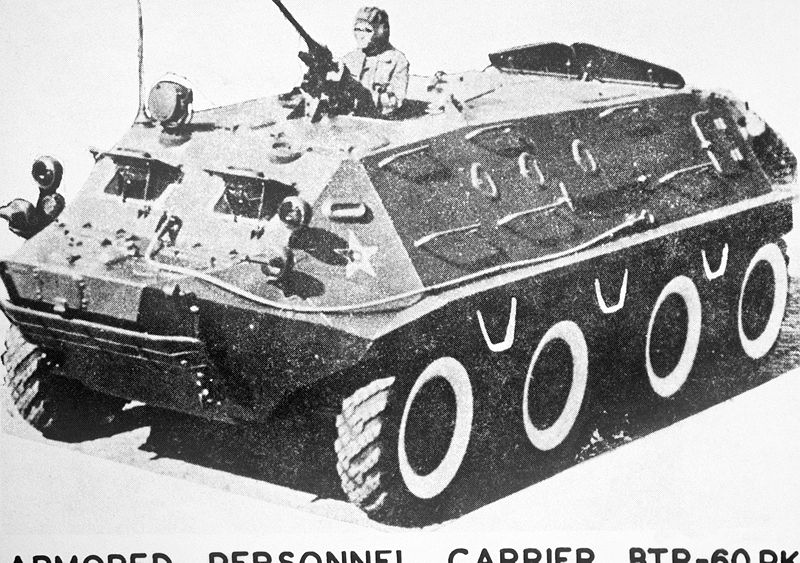
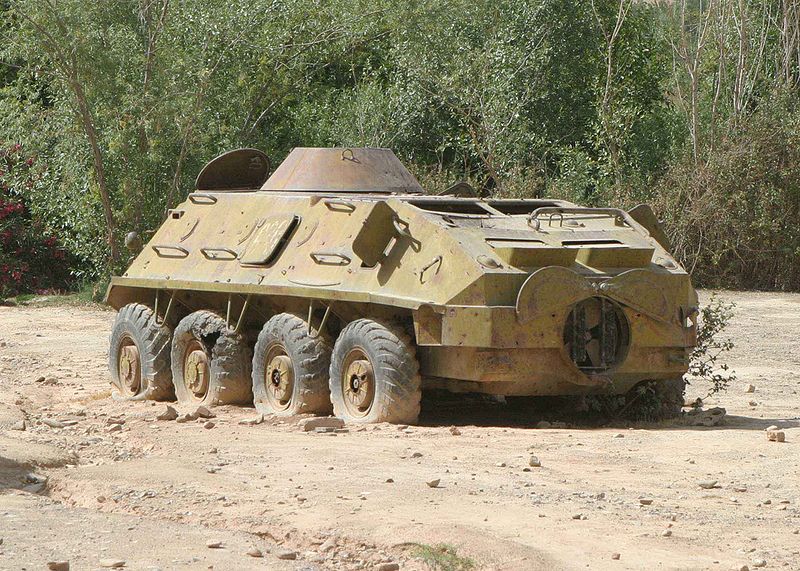
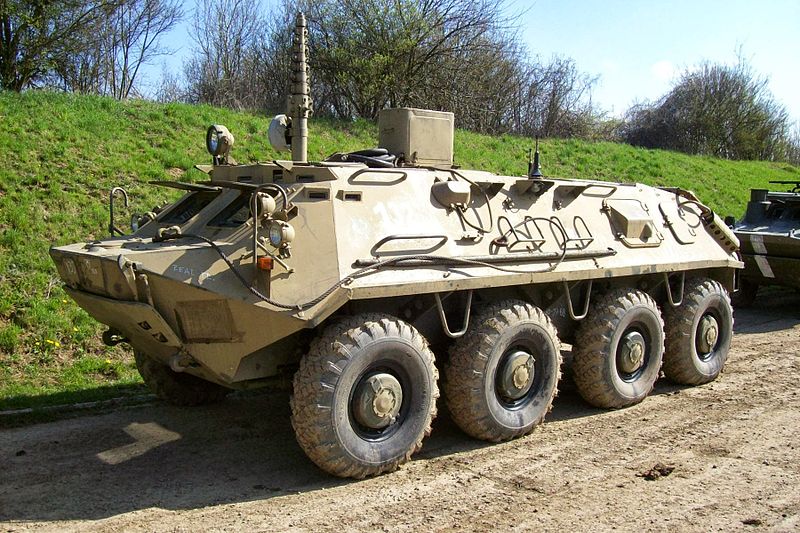
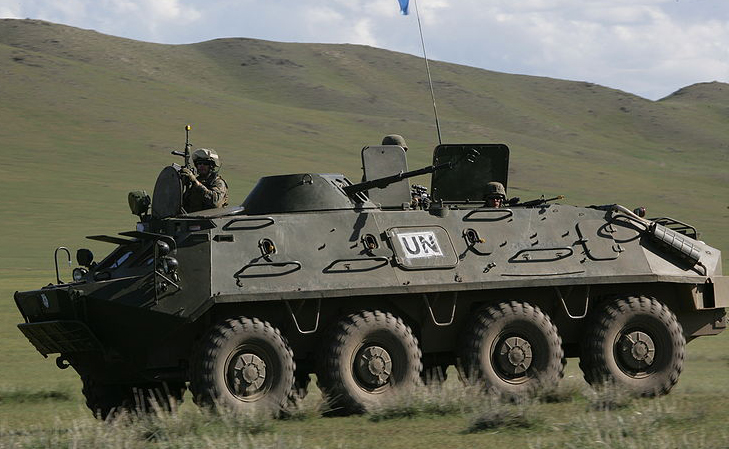
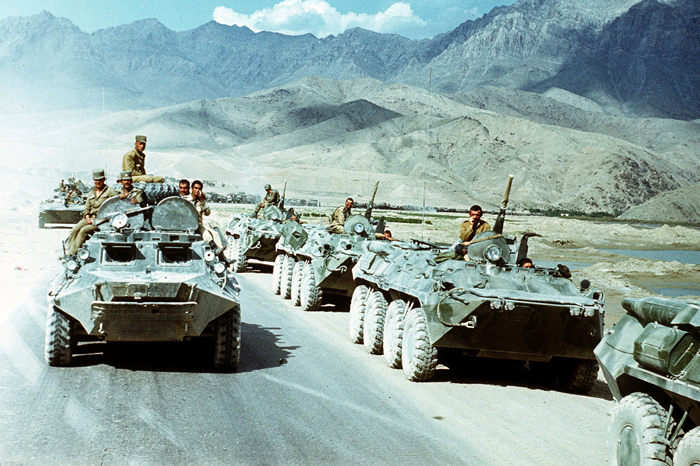
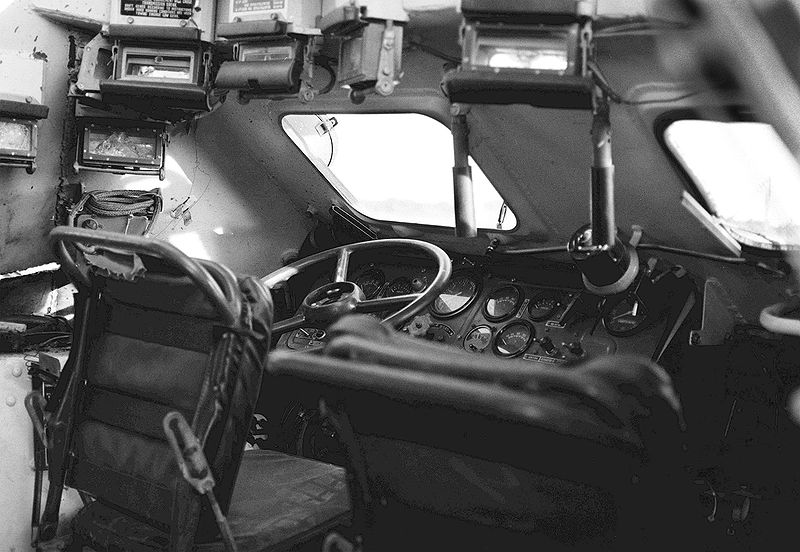
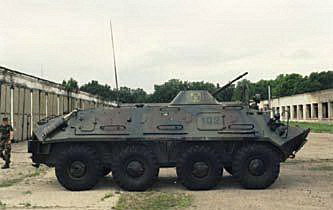
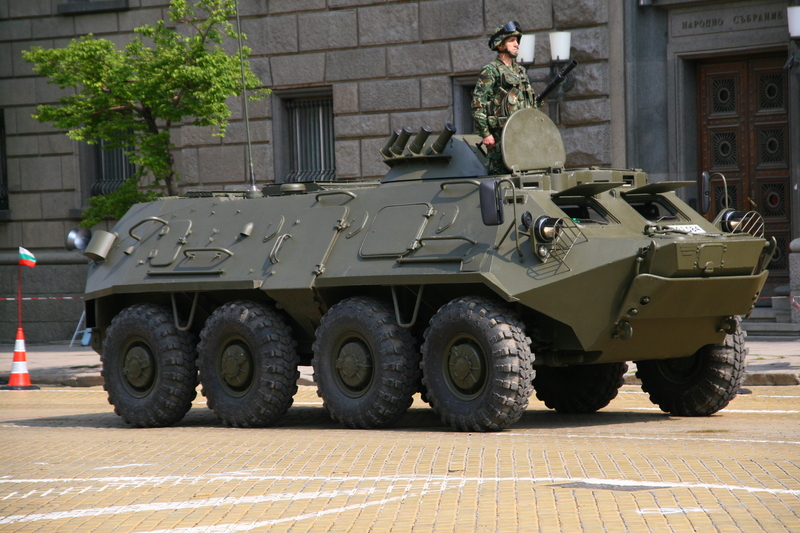
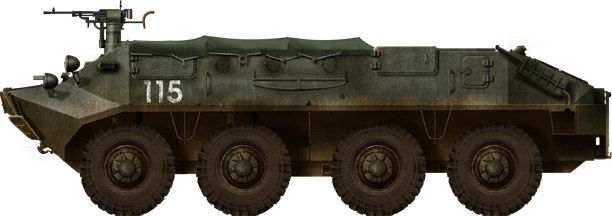
Early production BTR-60P of an unidentified rifle battalion with canvas, 1961-64.
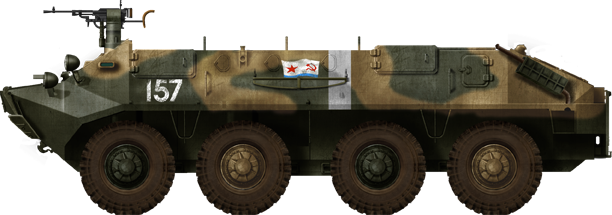
BTR-60P of a Marines rifle batallion, 1970.
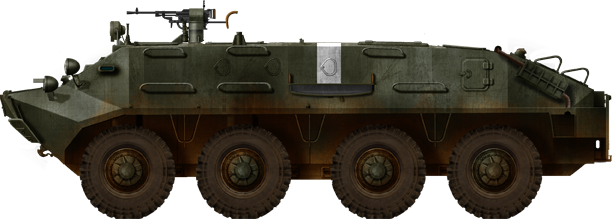
BTR-60PA, 1965.
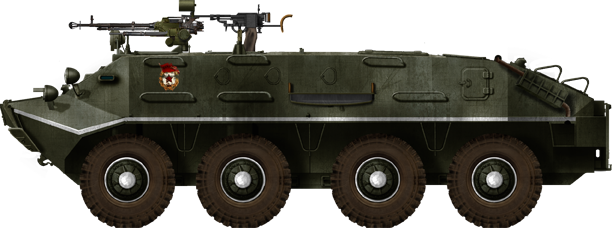
BTR-60PA, may 1969 victory parade, Moskow. Notice the armament of one DSHK HMG and two pintle-mount PKT MGs.
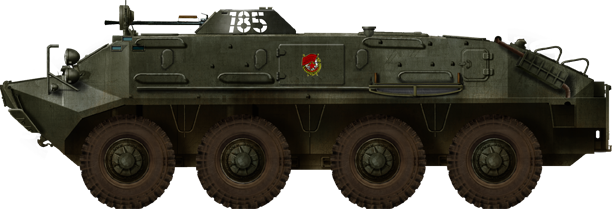
BTR-60PB soviet army guards unit, 1970.
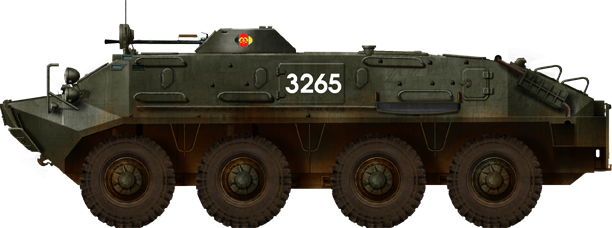
East German SPW-60PB, 1970s.
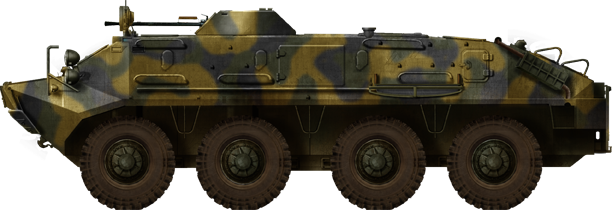
Syrian BTR-60PB, 1980s.
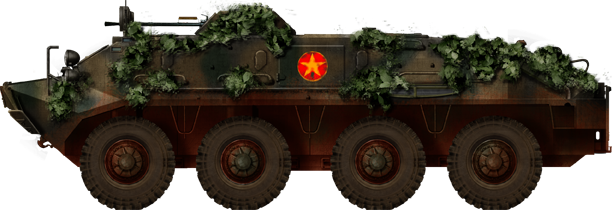
NVA army, 1972 offensive on Saigon.
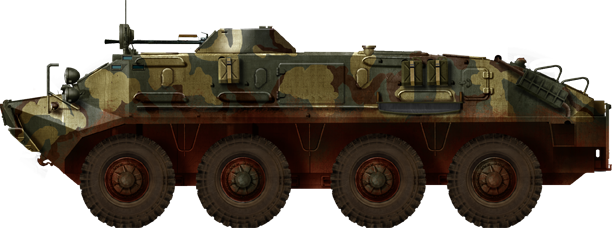
Camouflaged BTR-60PB of late production, 1970s
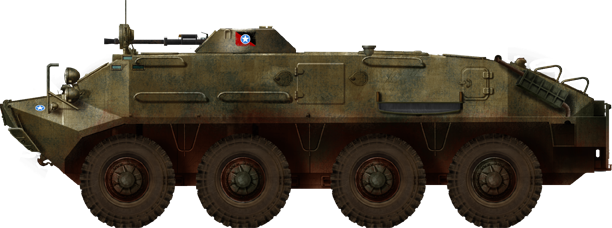
Somali BTR-60PB, 1990s.
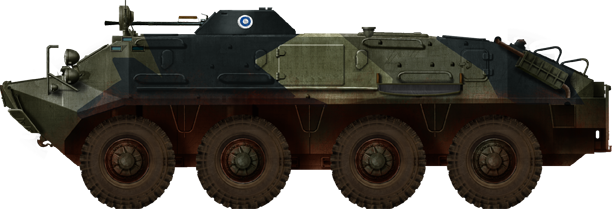
Finnish BTR-60 PB
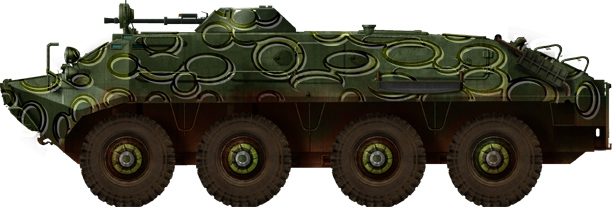
BTR-60 of the Afghan-Northern Alliance with its specific, rare camouflage.
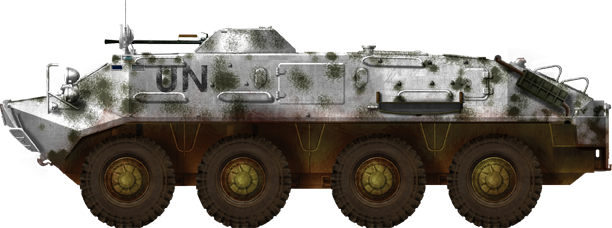
UN peace keeping forces BTR-60PB in Sierra Leone, 2002.
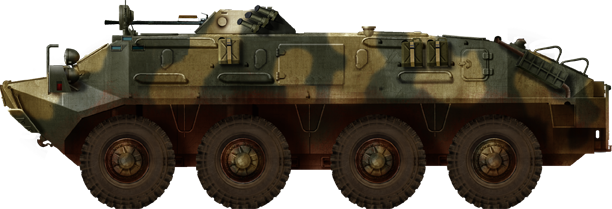
Algerian Forces BTR-60PB

Mexican Marines specialized vehicle
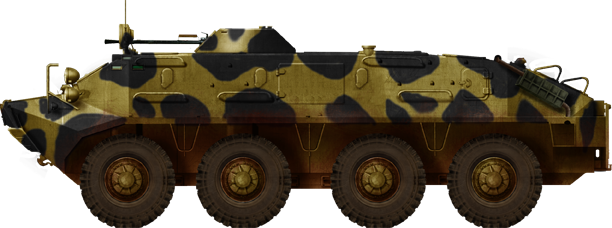
Libyan BTR-60, as of 2011.
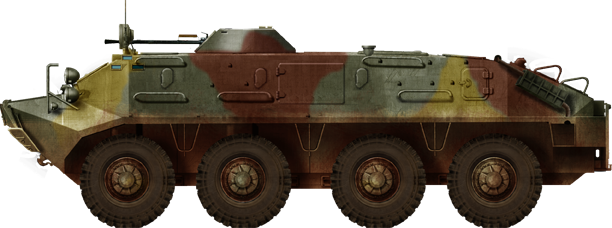
Egyptian BTR-60 in 1973, now displayed at Yad-La-Shiron Museum.
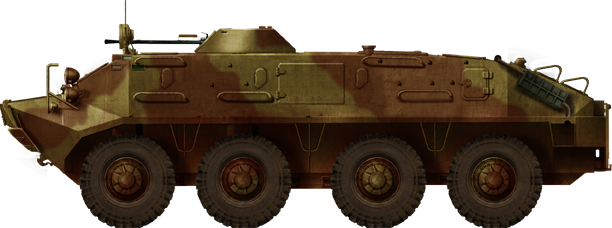
Iranian BTR-60PB
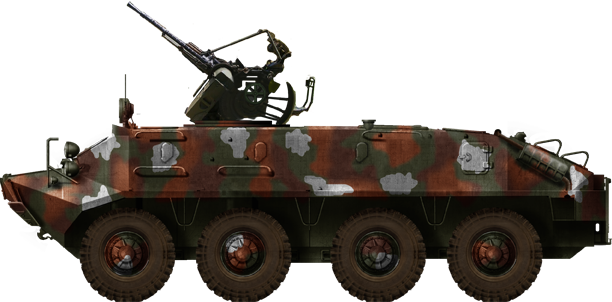
Iranian AA conversion of the BTR-60
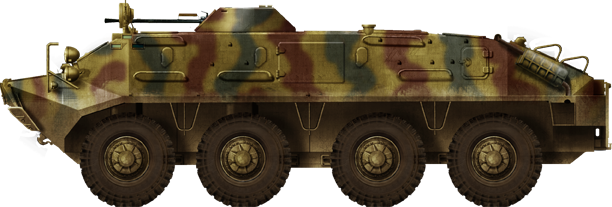
Yemeni BTR-60PB
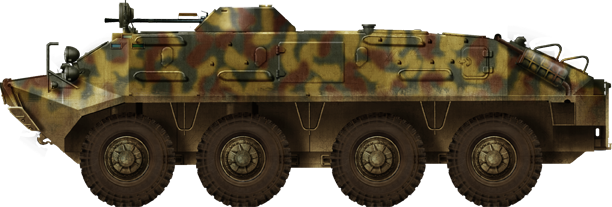
Bangladeshi Army BTR-60PB
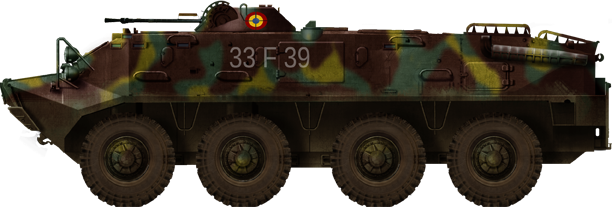
Romanian TAB-71
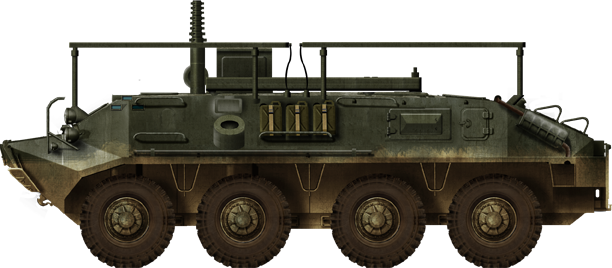
BTR-60PU-12 Air defence HQ vehicle

Cold War Tanks


































Cold war tanks posters

Cold War Main Battle Tanks

Cold War Soviet Army

